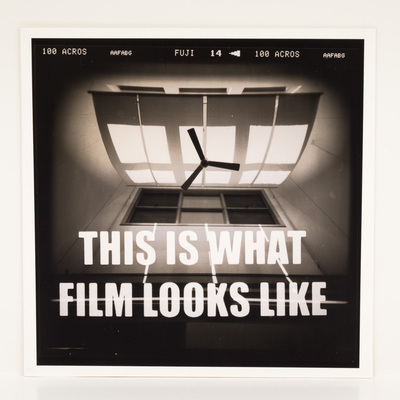In Camera, Retrospective

This is What Film Looks Like
Visit the Gallery for In Camera.
My Portfolio Projects class was described by the instructor as a group “independent study” — each student did their own thing, with frequent critiques and readings and writing papers. It wasn’t just about the work, it was the work surrounding the work, too.
That was confusing to write; it wasn’t confusing to do. I appreciated the “extra” work involved, as much as I moaned about the text, because I know if I want to go farther with this Art Thing, I need to be able to write about my stuff and how it connects to the wider world.
The final paper was a simple self-evaluation: what did I say I was going to do, and did I do it? What follows is more-or-less what I turned in.
To paraphrase my original proposal, I expected to end up with twelve chemical images commenting on current trends of digital manipulation to make digital images look like they were made with film, mounted as one piece for wall hanging.
What I actually ended up with was ten chemical images, plus one digital image, plus a box.
Challenges
- Figuring out how to get the text on the negative was the first challenge, and it delayed everything else by two to three weeks. (I didn’t get my first “real” image until Roll 8.)
- Needing to make the masks from lith film (rather than inkjet or laser printing) added a step I didn’t anticipate.
- Final image selection felt scant because I didn’t have much opportunity to remake images. I’m pleased with what I have, but there’s always that nagging thought that I could have done something just a bit differently.
- Lith printing was unsatisfying because of time constraints. Slower chemistry (more diluted) made more interesting prints, but I had to go faster to get finished.
- Toning felt rushed. More time might have given me a chance to make some new prints… but then again I might have just put it off anyway.
- I toned several images in three different kinds of chemicals (sepia, selenium, Berg Brown/Copper); I don’t have a good idea yet when each one is appropriate.
- Figuring out the final size of the images! I wavered from Big to Small to In Between, and even when I thought I’d figured it out (and cut the backing boards to match), I changed my mind. This meant cutting new backing boards.
- Getting the images all the same size, flush mounted on identically sized boards.
- I’ve never made a portfolio box before.
- The biggest challenge overall is dealing with the realization that I can’t “just make a new one” if I have some problem with a print. So that means I’m extra (possibly over) careful when working with the final images.
Successes
- I know of several ways to get text onto a negative before image exposure. Because of these experiments, I have two new projects in mind involving different methods and invoking different moods.
- Lith film development for graphic design purposes is pretty easy.
- I’m much more confident using medium format film and cameras.
- I know how to print and process fiber-based darkroom paper, and understand somewhat better when to use it. Future portfolio work (if chemical) is likely to use fiber paper, but class work will be RC simply for time issues.
- I made an awesome box.
- Photographers smile when they read the texts :)
What I Really Learned
Probably the most important thing is that I have a better idea of what my future projects are likely to be like. I don’t like being constrained by the idea that photography is either chemical or digital. It can be both at the same time. I don’t, however, wish to make digital look like chemical, and I’ve seen with this project that it’s really hard to make chemical look like digital. The issue then is to decide how much of each to bring to the table. That is a question for each project individually.
I also feel that it’s important for me to physically interact with the medium. For instance, my most satisfying work in my courses has included some method of presenting the image in a way other than matted and mounted on the wall. There is definitely a place for that type of presentation, and I will continue to make those sorts of prints. However, I will also always be thinking about how else my work could be presented so that I can help the viewer understand what I’m trying to say.
During the final review, I had more questions on the box than on the images. This isn’t so surprising, given that most people either dry mounted their images or put them into a Unibind book. I used the instructions from the Library of Congress, but be warned: you should make a prototype first to make sure you understand all of the instructions. This added a few extra days to my construction, but it was well worth it because the final box fits the image plates perfectly. The box took me about a day and a half to make, mostly waiting for the glue to dry.
There is one last unanswered question for me with this project: if I apply to Grad schools, how should I present this project? I suppose that is a question for next semester’s “capstone” class: Portfolio Seminar.